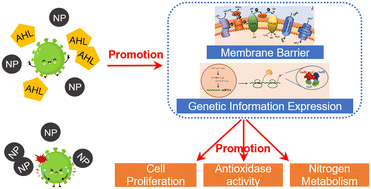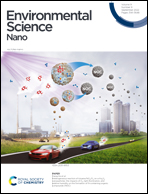Exogenous N-acyl-homoserine lactone-based quorum sensing regulation benefits Nitrosomonas europaea resistance to CeO2 nanoparticle acute stress†
Abstract
Adverse effects of nanoparticles (NPs) on biological nitrogen removal (BNR) systems have been extensively explored. However, little information is available on the system's resistance capacity and its improvement strategy to NP stress. We systematically investigated the effects and mechanisms of exogenous N-acyl-homoserine lactones (AHLs) with three different acyl-side chain lengths (N-hexanoyl-L-homoserine lactone (C6-HSL), N-decanoyl-L-HSL and N-tetradecanoyl-DL-HSL) at different concentrations on the resistance of Nitrosomonas europaea to acute CeO2 NP stress. All three AHLs promoted the NP-stressed cellular viabilities, ammonia oxidation performances, and superoxide dismutase activities. The required AHL dose to achieve the optimal anti-toxicity performance depended on its type. The shorter the acyl-side chain length, the lower the optimal acting concentration needed. 0.01 μM C6-HSL achieved the best cellular resistance capacity to CeO2 NP stress. The stimulations of the sulfate transport and metabolism in the presence of C6-HSL promoted the posttranslational modification related to the Fe–S cluster assembly, thus stimulating the electron transfer and aerobic respiration, which synergized with the facilitated ribosomal protein biosynthesis to improve the stressed cellular growth. Meanwhile, the activation of phospholipid transport and chaperone participation related to stress resistance maintained the membrane homeostasis that was actively involved in the promotion of the cellular resistance to NP stress. These findings would inspire a feasible strategy development of AHL-based QS regulation to alleviate NP stress for impaired BNR systems.



 Please wait while we load your content...
Please wait while we load your content...